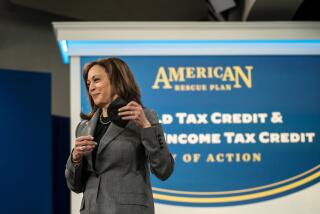Will the Flat-Tax Idea Fall Flat on Its Face? : Why so-called ‘tax simplification’ is so complicated
- Share via
Tax reform talk, specifically about a flat tax, is hot stuff these days. House Majority Leader Dick Armey (R-Tex.) and House Minority Leader Richard A. Gephardt (D-Mo.) each have bandied about the idea even before Congress gets down to serious work on a budget that probably will include a raft of new tax breaks.
A flat tax--applying the same tax rate to everyone--is simplicity itself. But is it too simple to work? The appeal of simplifying the current tax code with its mad maze of rates, exemptions and deductions is roaringly obvious. But to what extent would a flat tax unintentionally (or intentionally) shift the burden from the rich to the middle class and poor? Fairness and progressivity in any tax system are major concerns. Another is revenue: Would a flat rate worsen the deficit? And a flat tax would shift us to a consumption tax system from the current income-based system. Is that preferable?
Armey is pushing basically the same flat-tax proposal that floundered in the last session--a 17% plan that would eliminate most deductions. It would both lower the rate for many taxpayers and broaden the base of revenue collection. Armey would go so far as to eliminate the deductibility of mortgage payments for individuals. Alas for Armey, a 1994 Treasury Department analysis indicated that his proposal would cost about $186 billion in lost revenue. He now claims to have made changes to mitigate the shortfall.
Not to be undone, Gephardt this month proposed what he calls a “flatter” code so that four out of five Americans would be taxed at a rate of 10% to 11%. But his plan too would eliminate some popular tax deductions. Gephardt would retain higher rates for upper-income taxpayers, even after they lost these deductions. (The current rate income tax system has five brackets, ranging from 15% to 39.6%.)
In addition, there are other consumption tax plans, such as the “consumed income tax” proposed by Sens. Sam Nunn (D-Ga.) and Pete V. Domenici (R-N.M.). Under this plan, from your gross income you would subtract all savings and investments and income from savings and then, after deductions for mortgage, interest or tuition, you would pay tax on the remainder. The idea is to keep progressivity while encouraging saving and investment, an area where America is weak.
All these ideas are attractive, each in its own way. The problem is in the details. A flat tax was not even in the Republicans’ “contract with America.” The Clinton Administration so far has not weighed in on the issue, although Treasury Secretary Robert E. Rubin warns that a simplistic flat tax, among other things, would reduce government’s ability to apply public-policy leverage through the tax code. (Proponents argue it would also reduce special interest tax loopholes.) During the 1992 presidential campaign, it is remembered, Bill Clinton roundly criticized the flat-tax proposal of one of his opponents, former California Gov. Edmund G. (Jerry) Brown Jr.
Tax reform is one of those buzz phrases that excite voters, but it is a horrendously difficult issue. Washington ought to consider all the proposals carefully, so as to avoid further eroding its credibility with the voters. Certainly the flat-tax idea is worth exploring, but a word of warning: Some things that look good at first turn out to be anything but good when written into law.
More to Read
Get the L.A. Times Politics newsletter
Deeply reported insights into legislation, politics and policy from Sacramento, Washington and beyond. In your inbox three times per week.
You may occasionally receive promotional content from the Los Angeles Times.










